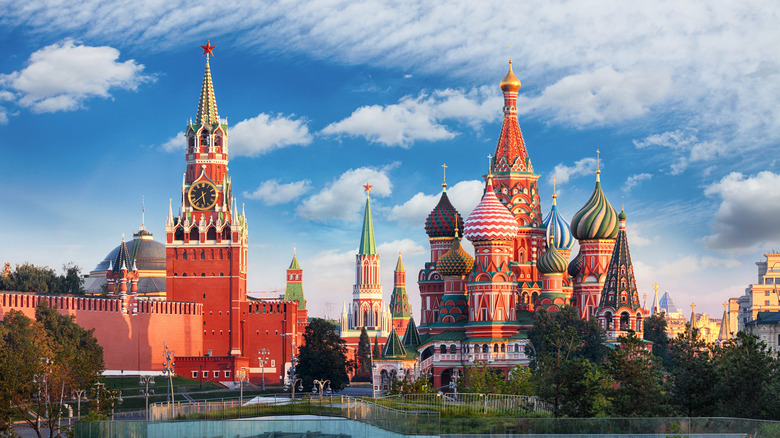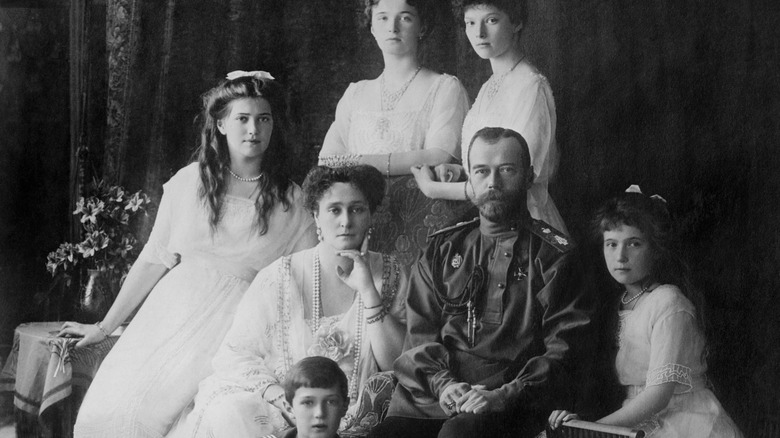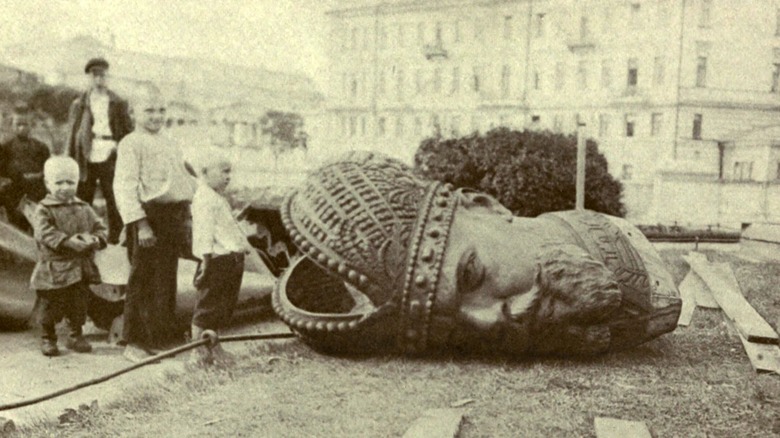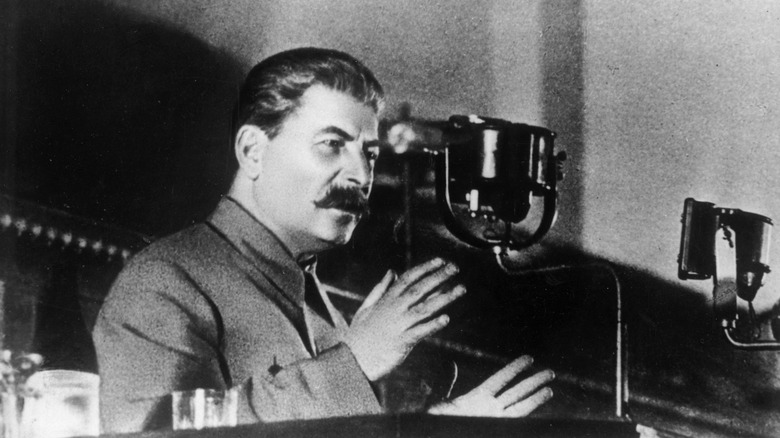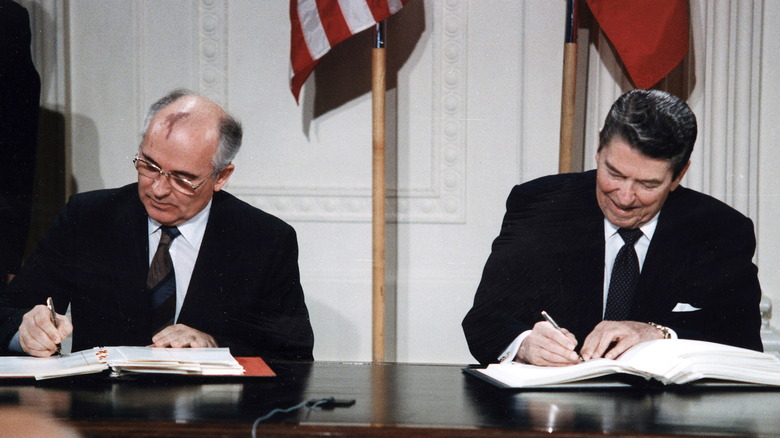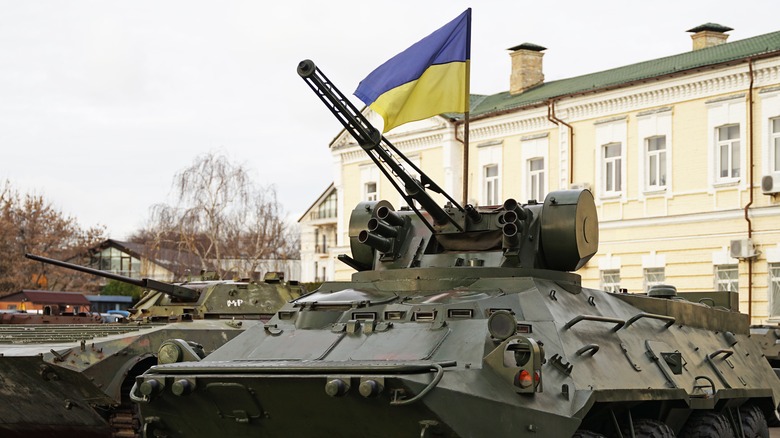Here's Why You Keep Hearing The Word Oblast
The 2022 Russian invasion of Ukraine left the global public with a lot of pertinent questions, chiefly amongst them: "Why?" Why has Vladimir Putin ordered the Russian military into another sovereign nation? Why does it matter so much to him, and what's his ultimate goal? Even as Ukrainian President Volodymyr Zelenskyy fights a boots-and-rifle war on the ground with the help of civilian militia, citizen-made Molotov cocktails, and a reservoir of seemingly limitless tenacity, Putin persists in a military engagement that resembles nothing less than the kind of last-generation, throwback war reserved for history books.
Amidst media circulation of facts and terms and the intertwined history of the two warring nations — Ukraine and Russia — one word might have caught the ear of astute listeners: "oblast." Knowing this single term is critical to understand Putin's motivations in attacking Ukraine (as much as we can), as well as Ukraine's staunch resistance to a mega-power it considers nothing less than an inhumane invader.
"Oblast" is a Soviet term stemming from the USSR's relatively brief — but immense in its geopolitical impact — 70-year rule from 1921-1991. Simply put, oblast means "territory," "region," "province," that kind of thing, as WorldAtlas explains. Oblasts were administrative centers (or political outposts) dotting Russia's vast landscape and were used to maintain and organize governance. And now, Putin wants one of the old Soviet oblasts, Ukraine, back under his control and away from European contact.
Russia under czarist rule
To understand oblasts, and therefore the present Ukraine-Russia conflict, we need to start with the central feature of Russia's character: its land. Russia's harsh, frozen expanse wilted the imperial ambitions of both Napoleon and Hitler, who sought Russia as a prize amongst prizes on the Eurasian continent. That same Russian land produced a lineage of hard, unforgiving leadership composed of immense pride, stark realism, and more than a dash of brutality. This kind of rule led directly to the Vladimir Lenin-led Bolshevik Revolution of 1917, which transformed Russia into a communist nation, as History describes.
In the centuries leading up to the birth of the Soviet Union in 1917, Russia was ruled by a czar. A czar was similar to an emperor, but as Britannica explains, there were absolutely zero legal limits placed on their actions. Their power was checked only by fear of Russia's dense network of noble houses or resistance amongst areas of Russia not yet fully conquered until the 19th century, like parts of Siberia, Manchuria, Kazakhstan, and yes, Ukraine.
The first Russian czar was Peter I, known as Peter the Great, who came into power in 1721. His ruling area expanded from Muscovy (one Russian state) to the "Empire of All Russias," again per Britannica. This kind of expansive but centralized leadership needed governors for outlying provinces. "Oblast" was a term that originated during this time and was used specifically to refer to polities of newly-absorbed Slavic peoples in eastern Europe (via WorldAtlas).
The Bolshevik upheaval
The Bolshevik Revolution of 1917 was one of the most jaw-dropping events of modern history — one that led to an equally shocking and rapid political turnaround. After centuries of czarist rule, Vladimir Lenin led a literal peasant revolt against the might of the Romanov dynasty and won.
For centuries, Russia had been composed largely of farmers. Its immense body of land was tilled by the many for the benefit of the few, and we don't mean in a metaphorical sense, but an institutional one. As History explains, Russia practiced serfdom, a system of feudal government where the poorest inhabitants owed debts of labor to a local lord. Feudalism was the norm in high medieval Europe (1000-1300 C.E.), where a rich lord lived in his "demesne" within the land he owned, while "unfree" serfs (i.e., bonded enslaved people) worked the surrounding land in family groups. WorldHistory explains that two to three days a week went to the lord, and the rest to generate food for one's own family.
Come the early 20th century, "backward" Russia — as Europe saw them — had simply had enough. In 1917, poor demonstrators demanding literal bread took to the streets of Petrograd (modern-day St. Petersburg) in immense numbers. Czar Nicholas II freaked out, abdicated the throne, and so started a six-year civil war of Red (leftist revolutionaries) versus White (allied capitalists) armies that resulted in a complete overthrow of the Russian monarchy and total restructuring of Russian society in 1921.
The iron curtain closes
Russia's conversion from peasant rebellion to cruel Soviet empire took only a few meager years. In 1924, dictator Joseph Stalin stepped into power following the death of revolutionary Vladimir Lenin and re-gripped Russia in a new iron fist. Per History, hundreds of thousands of political dissenters were sent to gulags and put to death. In Ukraine, 3.9 million people died of starvation in a Stalin-era famine dubbed the "Holodomor," as the dictator funneled food away from the poor in an attempt to modernize Russia into a military superpower.
As History describes, Ukraine was one of 15 Soviet states within the new United Soviet Socialist's Republic (USSR), or the "Soviet Union." Within these states, the old czarist term "oblast" was resurrected to describe regional administrative centers. Overall, there were 13 oblasts within the European mainland and 8 oblasts within Asia proper (via WorldAtlas).
To this day, when folks in the West hear the name "Russia," they probably still envision Russia post-World War II, during the Cold War (1946-1991): big red flags stamped with sickles and hammers, KGB spies and AK-47s, Cyrillic-scrawled agitprop posters featuring happy laborers and zooming airplanes (via The Guardian), and so on. This ultra-militaristic turn was due, in part, to World War II. Russia suffered the most deaths out of any nation at nearly 30 million, per the National World War II Museum. Much like Napoleon before him, Hitler sowed in the Soviet spirit a deep mistrust of anything "European."
The iron curtain collapses
Come the 1980s, Russia itself, top to bottom, was simply tired. Decades of social repression and KGB surveillance — the kind that persisted even through the '80s (via The Atlantic) — had taken its toll. By the time Mikhail Gorbachev came into power in 1985, the Soviet economy was stagnant, its politics were fatigued (per History), and its people were seeking new and restless forms of expression and popular culture (via Russia Beyond).
Gorbachev oversaw two dramatic policy shifts in the Russian government meant to overhaul the nation and keep up with modernity. Firstly, glasnost was a policy in complete opposition to the state secrecy that defined middle-of-the-century Cold War Russia, emphasizing complete governmental transparency in the eyes of the public. This included de-banning books, releasing political prisoners, opening up the doors to free speech and media criticism of the government, and even the participation of non-communist parties in governmental elections. Meanwhile, Perestroika addressed the economic side of things: For the first time since the 1920s, individuals and cooperatives — not the government — were allowed to own and operate businesses.
One by one, Soviet states declared their independence from the empire, starting with satellite states like Estonia and Lithuania that were harder to manage. On December 8, 1991, Gorbachev traveled to Minsk to sign an agreement freeing Ukraine and Belarus from the USSR. The rest of the states followed and created the new Commonwealth of Independent States. And yet, in less than a decade in 2000, Vladimir Putin would come to power.
A new Russian federation
So we come to the present, and can take each fact in order. Russia has always been prone to authoritarian rulers, a fact both inspired by and complicated by its immense geography and harsh physical environment. The term "oblast," during czarist Russian, was used specifically to describe hard-to-manage, outlying Slavic nations on the European/Russian border. Ukraine, a Slavic nation, was once a state within the Soviet Union managed within an oblast.
In the last few centuries, even as Europe looked down on "backward" Russia, European leaders such as Napoleon and Hitler did to Russia what Putin is now doing to Ukraine. Russian authorities, including Putin, neither respect nor trust anything west of Russia. Now Putin, an authoritarian, fears European involvement in what he considers to be Russia's historical turf, so to speak (as the BBC explains). This is why the single term "oblast" encompasses and exposes the entire relationship between Ukraine and Russia.
